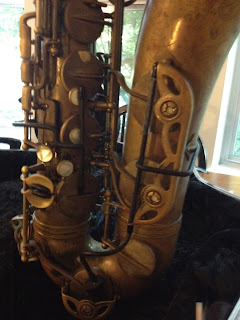Octave Displacement, Revisited: "Confirmation"
Since arriving at school a few weeks ago, I've been playing on my friend's 1920s-era Conn tenor since mine has been in the shop for routine maintenance. Actually, I hadn't ever taken my horn into the shop—partially because once college started, things got too hectic to take it out for maintenance, and also because I didn't know who to trust. At Banff, Greg Tardy recommended a gentleman named Ken Beason, who does repairs in Asheville, North Carolina. Greg's a stickler for detail and also knows quite a bit about horn repair himself; having heard Greg's enormous sound (I maintain that he has the biggest sound of any tenor player I've ever heard live—Chris Potter, J.D. Allen, Joe Lovano) and also taking into consideration his experience on the road, I thought I'd take a chance.
I knew the horn had been set up by the great Emilio Lyons at one point, but it was more than a decade since that overhaul and it turns out my horn had suffered some serious damage under the aegis of its previous owner. I got the horn back today and I have to say that Ken did really excellent work—the instrument is easy to play and the sound has much more presence than before. I thought that this might be a good time for a brief saxophone gear PSA: namely, the value of saxophone key clamps.
 Greg Tardy swears by these, as does Ken Beason, who claims that using them all the time (even on 10 minute breaks between sets) preserves the post-tune-up feel of a horn while also significantly cutting down on future routine maintenance. If I understand correctly, it helps keep the pads seated properly, which helps with the overall seal of the horn. It'll be another 3 years before I can really verify this claim, but considering how relatively inexpensive they are compared to routine maintenance costs, I'd urge saxophone players to give them a shot.
Greg Tardy swears by these, as does Ken Beason, who claims that using them all the time (even on 10 minute breaks between sets) preserves the post-tune-up feel of a horn while also significantly cutting down on future routine maintenance. If I understand correctly, it helps keep the pads seated properly, which helps with the overall seal of the horn. It'll be another 3 years before I can really verify this claim, but considering how relatively inexpensive they are compared to routine maintenance costs, I'd urge saxophone players to give them a shot.
Anyway, the point is that after I reunited with my horn today, I thought I'd see what I could do with it. A little while ago, I wrote about practicing octave displacement of bebop lines as a means of hearing wider intervals and challenging myself technically. I've made some progress, but there's still a long way to go until I feel like I can use this particular concept in a natural, fluid, and meaningful way. I played "Confirmation" with a bit of octave displacement with Chase Morrin—here's the result (the dragging is intentional?):
 Greg Tardy swears by these, as does Ken Beason, who claims that using them all the time (even on 10 minute breaks between sets) preserves the post-tune-up feel of a horn while also significantly cutting down on future routine maintenance. If I understand correctly, it helps keep the pads seated properly, which helps with the overall seal of the horn. It'll be another 3 years before I can really verify this claim, but considering how relatively inexpensive they are compared to routine maintenance costs, I'd urge saxophone players to give them a shot.
Greg Tardy swears by these, as does Ken Beason, who claims that using them all the time (even on 10 minute breaks between sets) preserves the post-tune-up feel of a horn while also significantly cutting down on future routine maintenance. If I understand correctly, it helps keep the pads seated properly, which helps with the overall seal of the horn. It'll be another 3 years before I can really verify this claim, but considering how relatively inexpensive they are compared to routine maintenance costs, I'd urge saxophone players to give them a shot. Anyway, the point is that after I reunited with my horn today, I thought I'd see what I could do with it. A little while ago, I wrote about practicing octave displacement of bebop lines as a means of hearing wider intervals and challenging myself technically. I've made some progress, but there's still a long way to go until I feel like I can use this particular concept in a natural, fluid, and meaningful way. I played "Confirmation" with a bit of octave displacement with Chase Morrin—here's the result (the dragging is intentional?):

You better add me to your "Les amis" page..
ReplyDelete